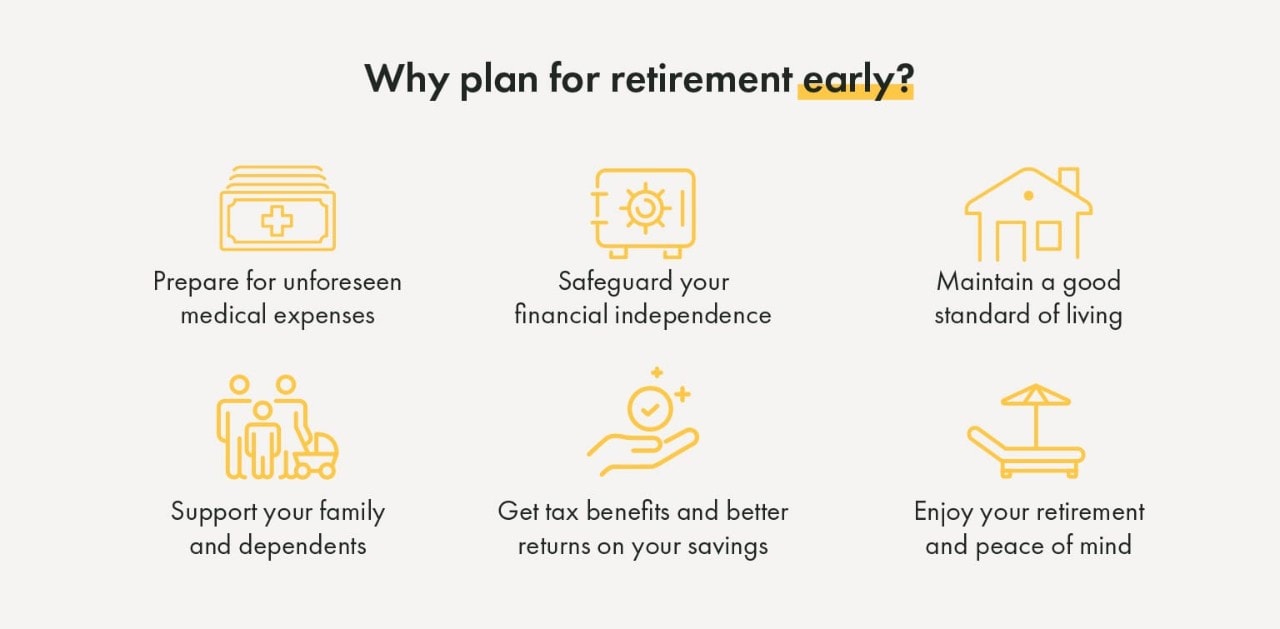- Not insured by the FDIC or any other government agency
- Not bank guaranteed
- Not a deposit or obligation
- May lose value


Financial planning for retirement should begin as early as possible and will evolve over time. Working with a wealth advisor can help you plan for the comfortable, secure, and fun retirement you want. Contributing to tax-advantaged savings accounts is only one piece of the retirement puzzle. While that source alone is unlikely to sustain the same quality of life in retirement, there are multiple sources of income, such as Social Security, you should include.
Planning for retirement can be a stress-inducing process. There are several unknown factors, and you have to save significant money for an event that won't occur for – potentially – decades.
To create a financial plan for retirement, you should start with two basic questions:
Even if you don't know the exact answer, a general idea will help you start to plan.
For example, if you're early in your career, you might have broader answers to these questions.
You may expect at age 30 that you'll have a retirement where you can travel, maintain a certain standard of living, and enjoy your favorite hobbies.
But if you've begun saving for retirement later in life, you may need to save a much larger percentage of your income to compensate for lost time. You can always adjust your goals up or down to meet your needs.
When creating your financial plan for retirement, you should consider a few global considerations:
Other major factors to build your plan around:
Consider the time horizon and your risk tolerance when determining an appropriate asset allocation. The farther your expected retirement date is, the more risk your savings and investments can withstand, within reason.

For instance, someone with 30 years or more until retirement could stand to invest significantly in stocks, if it also aligns with their objectives and risk tolerance.
Historically, stocks have outperformed other securities (i.e., bonds) over the long run. So while you will see periodic disruptions (potential losses) to the market, maintaining your investments over time should help you work toward your goals.
Retirement should be a period that you enjoy. At the same time, it's important to set realistic expectations.
As a retiree, you're no longer part of the workforce. Instead of spending eight hours per day at the office, you'll now have a day free to do whatever you want. That can mean traveling, shopping, sightseeing, or engaging in expensive activities.
Depending on your sources of income, budgeting for retirement could be helpful.
One source of income will likely be from Social Security. The amount you receive depends on your working years. Withdrawals can begin as early as age 62. While helpful, it's important to remember that Social Security is usually not enough alone for retirement.
If you still have a mortgage in retirement, remember to factor that into your monthly expenses. You may also experience medical issues, either expected or unforeseen.
One of the major factors affecting your retirement portfolio's longevity is your withdrawal rate. You can better calculate a reasonable withdrawal rate with an accurate estimate of your retirement expenses.
After determining the time horizon and spending expectations, you should determine the after-tax return rate on your investments.
For example, a return rate exceeding 10% (even for long-term investments) is often unrealistic.
As you age, if you rebalance your retirement portfolio to be less risky, the rate of return will lower because lower-risk investments usually yield lower returns. If you use the old standard $1m savings goal, your expected rate of return would be a more realistic 5%.
The effects of taxes on your retirement portfolio depend on your account(s). You'll have to pay taxes at withdrawal for the most popular 401(k) accounts. This means you should determine your return rate on an after-tax basis.
The tax rate applied to your retirement income will depend on the amount of income you have in retirement, including but not limited to, pension, taxable investments, rental income, and part-time work.
Planning for retirement doesn't have to be a difficult experience. Working with a wealth advisor can help you create a realistic and achievable retirement savings goal. At Yellow Cardinal, our wealth advisors have the experience you're looking for.
When looking to plan for retirement, contact us at Yellow Cardinal Advisory Group.
Graphic Image 1: Adapted from “Retirement Planning: How to Map Out Your Financial Success,” by Matthew Frankel, CFP, The Motley Fool. Updated June 8, 2022; https://www.fool.com/retirement/
Graphic Image 2: Adapted from “Types of Retirement Plans [Infographic],” by Ron Weber, Quicken; https://www.quicken.com/types-retirement-plans-infographic
The information on this page is accurate as of September 2022 and is subject to change. First Financial Bank and Yellow Cardinal Advisory Group are not affiliated with any third-parties or third-party websites mentioned above. Any reference to any person, organization, activity, product, and/or service does not constitute or imply an endorsement. By clicking on a third-party link, you acknowledge you are leaving bankatfirst.com. First Financial Bank and Yellow Cardinal Advisory Group are not responsible for the content or security of any linked web page.
This material is provided for informational purposes only and should not be construed as investment advice. Guidance provided is educational in nature, is not individualized, and is not intended to serve as the primary basis for your investment or tax-planning decisions. All investing involves risk, including the risk of loss. Investment risk exists with equity, fixed income, and alternative investments. There is no assurance that any investment will meet its performance objectives or that losses will be avoided. Investors should fully understand the risks associated with any investment prior to investing.
You are about to go to a different website or app. The privacy and security policies of this site may be different than ours. We do not control and are not responsible for the content, products or services.
Online banking services for individuals and small/medium-sized businesses.
If you haven't enrolled yet, please enroll in online banking.
Yellow Cardinal resources
* Are not insured by the FDIC. Not a deposit. May lose value.
f1RSTNAVIGATOR is where our business clients can access tools to help manage day-to-day account activity.